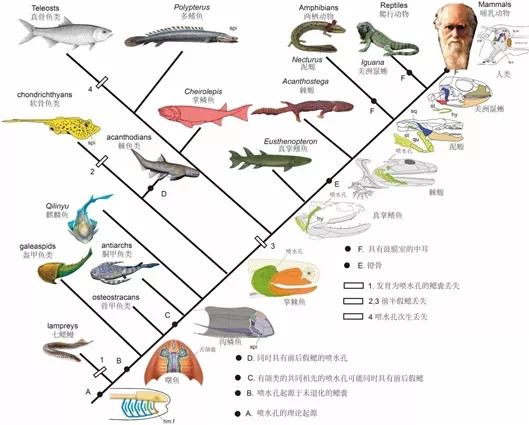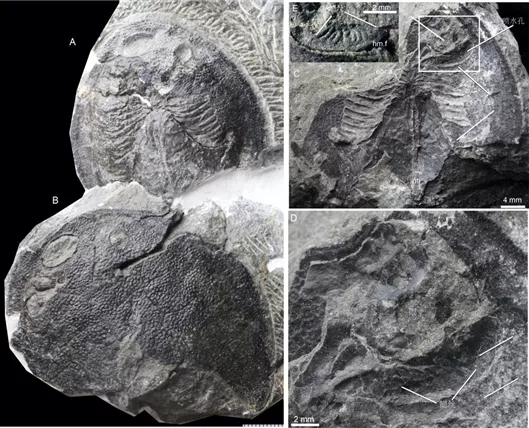At present, there is sufficient embryonic and fossil evidence to prove that our middle ear evolved from the blowhole of fish, and where did the blowhole of fish come from? This is a century - long problem that has puzzled the academic circles. Recently, gaizhikun, researcher of Institute of Vertebrate Paleontology and Paleoanthropology, Chinese Academy of Sciences, and scientists from China, Britain and Sweden (Sweden), as the first author, published the latest research results on the origin of vertebrate Blowholes in frontier of ecology and evolution, revealing for the first time that the human middle ear was once the gill used by fish to breathe**

Evolution of the blowhole from gill of the aganathia to middle ear of the human beings. (provided by gaizhikun and painted by Shi aijuan)
The human middle ear includes the tympanic chamber, the three auditory bones that conduct sound, and the eustachian tube that leads to the oral cavity, which is the secret of human sensitive hearing. The blowhole of fish is an incomplete branchial fissure between jaw arch and lingual arch, which only contains pseudogills. It is a very important respiratory organ of fish. Among the cartilaginous fishes, the blowhole is mainly used to suck in water flow, which is the survival secret for benthic cartilaginous fishes to adapt to the life on the sea floor. Among the primitive bony fishes, the blowhole is mainly used to breathe air, which is an important reference for studying how early fin fishes boarded the land to breathe air and adapt to the life on the land.

The first discovery of gill filament marks in the early Devonian wide turtle fossils in Qujing, Yunnan, reveals that our middle ear was once the gill used by fish to breathe (Photo by gaizhikun)
A century old problem that puzzles academic circles
As early as 1822, the French anatomist Saint Sealand published his classic work "anatomical philosophy", which proposed a priori that similar organs of different vertebrates may evolve from the same prototype. This may be the earliest scientific guess about the origin of fish Blowholes in the history of science. In 1872, Carl Gegenbaur, a famous German anatomist, was the first to put forward the segmentation theory of vertebrate head from the perspective of detailed anatomy (including branchial arch, brain nerve, muscle, etc.), holding that the jaw arch and lingual arch of vertebrates, like the common branchial arch behind them, are a series of homologous structures and are one of the segments of the head.
In 1937, Watson, a British paleontologist, further put forward the "aphetohyoidean theory", which held that the lingual arch supporting the jaw arch in the gnathognaths was not initially jointed with the jaw arch, but a common branchial arch. Therefore, there should be a complete and undeveloped branchial fissure between the jaw arch and the lingual arch, rather than a water jet hole, representing a primitive state of the early gnathognaths.
This view inspired paleontologists in the 20th century to search for such a non degenerated branchial cleft between the jaw arch and lingual arch of early gnathognaths. After a century of searching, paleontologists from various countries have carefully examined the fossils of all pelagic fishes, ratchet fishes, cartilaginous fishes and bony fishes in the present gnarless and early gnawed fishes, and have not found any exact fossil evidence.
Fossil evidence from China
Since 2002, the research team has carried out field work in the Silurian strata of Changxing, Zhejiang, and found the most primitive fossil of euhelmeted turtle here, which was later named Shuyu. These Shuyu fossils are precious specimens with three-dimensional cartilage brain preservation, and they are all very small. They are only as big as our fingernails. They are very suitable for three-dimensional non-destructive scanning using synchrotron radiation X-ray microscopic imaging technology, a large scientific device.
In 2006, the research team took the brain specimen of the dawn fish to the Swiss light source in Zurich, Switzerland for nondestructive scanning.
After that, the three-dimensional reconstruction software was used to carry out three-dimensional virtual restoration of the brain of the Shuyu. It took five years to complete the three-dimensional reconstruction of seven brain fossils of the Shuyu. In the brain only the size of a fingernail, almost all brain regions, sensory organs, nerve and vascular channels in the head of the Shuyu were reproduced.
Through the in-depth study of the three-dimensional virtual model of the head of the Daw fish, the research team found that the so-called inter branchial ridge of the armored fish is actually the dorsal part of the branchial arch, which is the same as the Swedish paleontologist Si Tianxiu's conjecture of the bony armored fish in 1927, that is, the more the branchial arch and the brain of the armored fish become a head armor that plays a major role in protection, which is similar to the more the ribs of the turtles become enlarged and the more the shells are formed.
Compared with the bony armored fish, the whole gill arch of the Daw fish also maintains the original state of the whole vertebrate. Therefore, it is easy to identify the jaw arch and tongue arch from the topological position. Its jaw arch is just behind the orbital foramen, forming the posterior wall of the orbit. Moreover, the armored fish has only 7 pairs of pharyngeal arches, respectively for the jaw arch, tongue arch and 5 pairs of gill arches that should have jaws.
At the same time, the brain nerve of the dawn fish has also been accurately restored. After the facial nerve originates from the back brain, it leads to the first branchial sac behind the eyes along the anterior semicircular canal of the inner ear. Therefore, many evidences, such as the number, topology, morphology and innervation of gill sacs, point out that the gill sacs behind the eyes of armored fish are the lingual jaw sacs located between the jaw arch and the lingual arch.
Judging from the morphology, the glossomaxillary sac is the same as the five gill sacs behind it, and it opens on the ventral surface of the head armor, not on the back of the head armor like the water spray hole. Therefore, it is basically judged that the glossomaxillary sac of the armored fish is still an undiminished gill sac. However, in order to prove that it is a gill with normal respiratory function, there is still a lack of the last link in the whole chain of evidence, that is, the fossil evidence of the existence of gill filaments in the gill sac.
For this reason, the research team has carried out field excavation for several years in the early Devonian strata of Qujing, Yunnan. Through the continuous and unremitting efforts of the research team, the first new material of the broad turtle that completely preserved the gill filament marks in the first gill pouch behind the eyes was finally collected in the dark gray siltstone of xishancun formation near the Miandian reservoir in Qujing, which further proved that the first gill pouch behind the eyes of the armored fish is a gill with normal respiratory function, rather than a degenerated water spray hole, This provides the most exact anatomical and fossil evidence for the origin of vertebrate blowholes.

Four stages of evolution from fish blowhole to human middle ear. A. True palm fin fish and its spray hole section; B. Spiny newt; C. Ichthyostega and its middle ear section; D. Reptile and its middle ear section; E. Mammal and its middle ear section (A-E, from Gai et al. 2022, painted by Shi aijuan)
Eustachian tube used to be the main channel for fish respiration
On this basis, the research team summarized the evolution process of the blowhole from the jawless to the quadruped, thus establishing the evolution sequence of the blowhole from the gill of the jawless to the human middle ear.
This sequence shows that: with the division of paired nasal sacs of armored fish, an abnormally developed middle dorsal hole (single nostril) is developed in front of the head armor to act as the main respiratory organ for water suction. Therefore, the lingual jaw sacs between the jaw arch and the lingual arch have developed into a complete gill sacs for the first time. This gill sacs, like the following five normal gill sacs, have complete front and rear half gills, and the half gills have gill filaments, which is the main place for gas exchange.
With the origin of jaw and double nostrils, the jawbones have successfully evolved into double nostrils, but the double nostrils are not connected with the oral cavity, and have no respiratory function but only olfactory function. However, the respiratory needs of fish have not decreased. Therefore, the first gill sac behind the eyes (glossomaxillary SAC) has been transformed into a spray hole, which has become the main respiratory organ. This has already happened in the most primitive pelagic fish, the most primitive pelagic fish, the carcass beetle (ditch scale fish) and the most advanced full jaw pelagic fish (Kirin fish), both have spray holes, Therefore, the blowhole probably originated with the appearance of jaw and double nostrils in the presence of jaw like companion.
In cartilaginous fish, the water spray hole is mainly used to suck in water, while in bony fish, it is mainly used to breathe air. For example, in living multi fin fish, the head will be exposed to the water, and the air will be breathed through the small hole called "water spray hole" on the head, and a loud "breath sound" will be emitted.
All these evidences show that early bony fishes have the ability to breathe air from the blowhole. As a new way of breathing, it is likely to be a pre adaptation feature for fishes to leave the water area and board the land to breathe air, thus providing a prerequisite for fishes to board the land to breathe air.
With the origin of the inner nostril in the SARCOPTERYGII (e.g. Kentucky), the passage between the nasal cavity and the oral cavity has been successfully opened, and the nostril has become the main respiratory organ, thus laying a further foundation for the fish to land and breathe with the lungs. The quadrupeds on the land, facing a new environment, have to develop new senses in order to better survive in the air.
In this way, the blowhole, which has lost its respiratory function, has been modified and gradually evolved into our middle ear cavity - tympanic chamber, while the lingual jaw and the square bone and joint bone of its joints have also gradually degenerated and become smaller. Finally, it enters our middle ear and evolves into the three auditory bones of our middle ear. It has been renamed as stapes, malleus and incus, which are responsible for transmitting sound to the brain. We humans finally have sensitive hearing.
Therefore, if it were not for the bold experiment of these prehistoric fishes breathing air through the blowhole on their heads, we might never have evolved such sharp hearing. Our ears and mouth are still connected, and it is the eustachian tube evolved from the blowhole that connects them.
Now the eustachian tube, like our cecum, seems to have no function, but it used to be the main channel for fish to breathe. Now it has become an evolutionary remnant left by fish. In other words, our fish ancestors used to breathe with our ears. Biological evolution is so wonderful.
Co authors of the study include Zhu Min, an academician of the Chinese Academy of Sciences, and Philip C.J, an academician of the Royal Academy of Sciences. Donoghue and per e, academician of the Royal Swedish Academy of Sciences. Ahlberg.
The research was supported by the strategic science and technology pilot program of the Chinese Academy of Sciences, the National Natural Science Foundation of China, the key research program of Frontier Science of the Chinese Academy of Sciences and other projects.